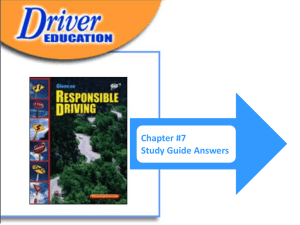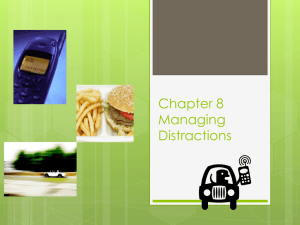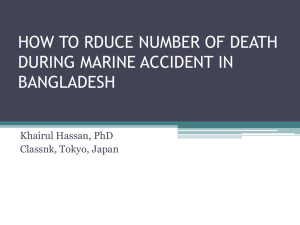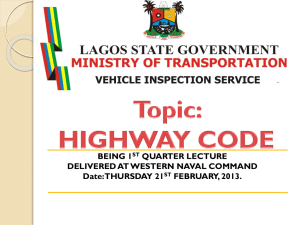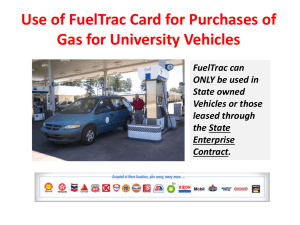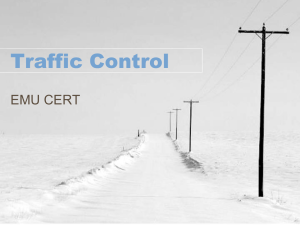Document
advertisement
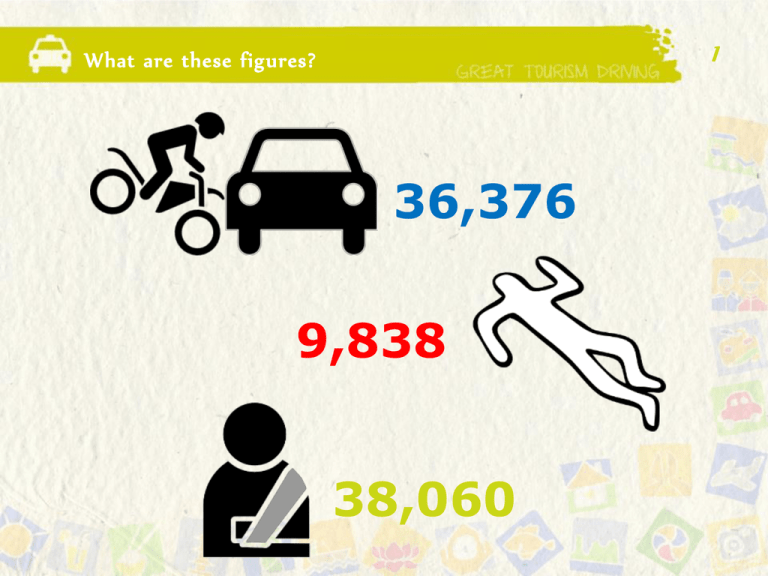
1 What are these figures? 36,376 9,838 38,060 Module three Topic two Driving safety Why Drive Safely? 1. Accident costs much 2. Tourist expectation not met 3. Driver expectation not met 4. Government is concern 3 Accident costs? • Physical damage • Property damage • Medical costs • Liability costs 1. Damage to: • Your vehicle • Yours and passengers’ property • Other vehicle/s 2. Injuries. 4 5 Driving Safety Statistics • Someone is injured every 18 seconds • A person dies in a crash every 11 minutes • Over 2 million injuries annually are disabling • Motor vehicle accidents are the most common cause of death • 1 in 4 fatal work injuries involves a vehicle accident. Road Traffic Accidents: The modern Killer 6 Globally 1.2 million die in road accidents every year 50 million are injured A further * Next Generation Healthcare/ WHO Global Road accident deaths 7 * Next Generation Healthcare/ WHO Global deaths: income group 8 Low income countries 21.5 deaths per 100,000 Middle income countries 19.5 deaths per 100,000 High income countries 10.3 deaths per 100,000 * Next Generation Healthcare/ WHO 9 Global Deaths Vs Registered vehicles Population Road traffic deaths Registered vahicles High income countries Middle income countries Low income countries * Next Generation Healthcare/ WHO Viet Nam: 10 number of accidents, deaths and injuries Accidents Deaths 40000 Injuries 35000 30000 25000 20000 15000 10000 Injuries 5000 Deaths 0 2010 Accidents 2011 2012 Viet Nam traffic accidents • Highest number of traffic accidents compared with other ASEAN countries • One of the highest number of traffic accidents in the world. 11 Some accidents 12 • Dìn Ký tourist boat - 16 died - Driver: no driving license • A collision between a tourist bus and a train in Hanoi: 9 died. Tourists expectation • Life is not at risk • Healthy and safe • Enjoy the trip and local tourist attractions. 13 Driver expectation 14 • Safe and sound journey for ALL • No risks for driver’s own health • No damage for vehicles • No damage for others’ health and properties. • Achieve Company’s expectation of high standards of performance, including safe driving. Government’s efforts 1. National Traffic Safety Committee chaired by a Deputy Prime Minister 2. Provincial Traffic Safety Committee 3. Traffic safety campaigns 4. TV news programme on traffic safety every morning 5. Safety driving education 15 Causes of traffic accidents in Vietnam 1. 90% by Traffic attendants 2. Less than 2% by Traffic infrastructure 3. 1% by Traffic vehicle 4.60% accidents caused by drunken drivers 16 Recognize Driving Hazards 1. Do you identify the variety of you could face on the road? driving hazards 17 Recognize Driving Hazards: Human Error - Drivers 1. Skills and experiences 5. Distracted driving 2. Driving attitude 6. Fatigue, tired, … 3. Personal moods and emotion 7. Failure to keep vehicles in 4. Reckless driving good operating condition 8. Driving under the influence. 18 Driving hazards: Dangerous Conditions 1. Bad weather 2. Difficult road conditions 3. Poor light or glare 4. Poor visibility 5. Heavy traffic 6. Road work 7. Accidents 8. Vehicles 19 Activity 3.2.5 Driving Hazards: Quiz • Reckless driving • Distracted driving • Fatigue • Aggressive driving • Vehicles in poor operating condition • Driving under the influence 20 Activity 3.2.5 Driving Hazards: Quiz • Bad weather • Difficult road conditions • Poor light or glare • Heavy traffic • Road work • Accidents 21 22 Factors that help driving safely Driving safely Driver Vehicle Environment Defensive driving • Driving to save lives, time, and money, in spite of the conditions around you and the actions of others (Source: http://en.wikipedia.org/wiki/Defensive_driving) • Using knowledge and skills to drive in such a way that: - Do not cause accidents - Do not involve in accidents. - Not being in a conditions to invite accident. 23 24 FIVE key principles of defensive driving Knowledge Alertness Foresight Skill Good judgment 25 Activity 3.2.6 Posters: Steps of Defensive Driving Draw a picture that clearly presents the 5 steps of Defensive Driving! 1. Search or Scan 2. Identify 3. Predict 4. Decide 5. Execute 26 What are the precautions for defensive driving? Activity 3.2.7: Problem solving & experience sharing. 27 How do you prepare your tourist vehicle in case of bad weather? Work in 3 groups of 6-8 persons for discussion (10 min.) and prepare for group presentation (3 min. max.): Group 1: Prepare taxi – mini bus – coach Group 2: Prepare motorbike – xe om Group 3: Prepare cyclo Pre-driving preparation Problem solving & experience sharing: How do you prepare your vehicle in case of bad weather: rain, sunny, … to serve tourist? 28 29 Eliminate driving hazards: Pre-Drive Inspection Walk around inspection Windows clean, nothing blocking vision Lights working properly Mirrors properly adjusted Tires Leaks under vehicle Eliminate driving hazards: Vehicle Maintenance Regular tune-ups and check: daily, weekly and periodically • Oil changes • Fluid levels • • Brakes Tire treads and pressure • • Lights, signals, and wipers, mirrors. 30 Eliminate driving hazards Adults and children over 6 years who drive or sit on motorbike have to wear helmet. 31 Don’t Drink or Take Drugs and Drive • Alcohol and drugs impair: - Ability to determine distances - Reaction time - Judgment - Vision Some medicines can also make drivers drowsy (e.g. cold and flu meds, anti-histamines, etc.) • Remember: - Only time, not coffee, will sober you up - Ride with a designated driver. 32 Eliminate driving hazards: Seat belts Seat Belts • Saved many lives, both driver and passengers (if seat belts are provided) • Prevent crashing into steering wheel, dash or windshield • Keep us inside vehicle • Protect body organs • Improve chance of remaining conscious • Keep us behind the wheel if we have to swerve or brake suddenly. 33 Eliminate driving hazards: Carrying a Load? • Don’t overload your vehicle or motor-taxi • Make sure everyone has a seat and a seat belt • Make sure cargo is properly secured • Be certain your vision is not blocked. 34 Obey Traffic Rules & Use Common Sense • Speed limits • Traffic signs and signals • Signal your intentions: before overtaking, changing direction or reversing • Pass with care and only where allowed. 35 36 Follow the 3-second rule Input text Input text Maintain a minimum safe distance with driver s in front Do not drive too close Foresee situations and avoid brake too urgently. 37 38 Do you use mobile phone when driving? Should you? DO NOT. It makes you distracted ! You need to keep alert all the time. At the speed of 110 KM/Hours….. 45 Meters 39 Meters 35 Meters 31 Meters Normal Drink alcohol Using mobile phone (with headphone) Using mobile phone (in hands) Activity 3.2.8: Problem solving: Group Work 39 Work in groups of 4-6 to solve driving problems. Each group must solve a problem (in 10 minutes) and present it to the rest of the class in 3 minutes for class discussion. • Group 1: - What would you do to keep alert and be prepared? - How can you avoid the unexpected collisions? • Group 2: - What should be considered when driving tourists in a vehicle (cyclo, xe om, taxi,) in heavy rain or flooded street? - What do you do to adjust to weather & road conditions • Group 3: - What are extra care if driving at night and trouble with lights? - What would you do when passing an intersection? • Group 4: - What would you do for watching out for fatigue - What would you do if you get unexpected traffic? • Group 5: - What would you do when driving on a slope? - What would you do at a curve road? Activity 3.2.8: What would you do to keep alert & be prepared? – Group 1 • Keep your mind on your driving and your hands on the wheel • Scan the road ahead for problems • Check mirrors frequently • Expect the unexpected • Yield to other drivers who are determined to get there first 40 41 Avoid Collisions Collision situations: Insert text Insert text Insert text Insert text How can you avoid the following unexpected collisions? Insert text Insert text Insert text Insert text 42 How to break and stop safely? • Observe • Anticipate • Decide • Act • Time – Stop. • Brake & release: will help 1. Avoid skidding 2. Dry the break wheel 3. Check break if works 4. Alert the vehicle behind. Break and stop urgently may cause accidents! 43 44 What is the safe parking distance? Tourist Minibus Dry Wet 56kmph 72kmph 88kmph 104kmph Meters0 50 100 150 200 45 What is the safe parking distance? Tourist coach Dry Wet 56kmph 72kmph 88kmph 104kmph Meters0 50 100 150 200 250 46 What is the safe parking distance? Motorbike Dry Wet 56kmph 72kmph 88kmph 104kmph Meters0 50 100 150 200 250 47 How do you pass other vehicles safely? Heading text text text text text text text 8. abcdefghijkl 3. abcdefghijkl 2. abcdefghijkl 1. abcdefghijkl 5. abcdefghijkl 4. abcdefghijkl 7. abcdefghijkl 6. abcdefghijkl 10. abcdefghijkl 9. abcdefghijkl Activity 3.2.8: What would you do & why? – Group 2 48 Problem solving: Driving tourists in a vehicle (cyclo , xe om, taxi, …) in heavy rain or flooded street? What do you do to adjust to Weather & Road Conditions Slow down, maintain appropriate speed • Turn on lights and wipers • Increase following distance to 4 seconds • • • • Avoid puddles Beware of misty rain after a dry spell Be prepared to handle a skid safely. Don’t break urgently • Beware oil on the road in wet weather • Don't impede the flow of traffic • Stop safely if necessary 49 Activity 3.2.8 : What are extra care if driving at night & trouble with lights? – Group 3 • Keep windshield clean to improve vision • Turn lights on 1/2 hour before sunset • Increase following distance to 4 seconds • Be extra careful on curves and at intersections • Switch from high to low beams to keep from blinding other drivers • If you have trouble, pull completely off the road and use flashers. 50 What would you do when passing an intersection? 51 • Rule of yielding to other drivers • Watch out the road for problems. • Clearly decide your direction • Show your intention Activity 3.2.8: What would you do for watching out for fatigue – Group 4 • 52 Be especially careful during late night, early morning, and mid-afternoon hours • Stop, take a nap, or get some exercise if you’re tired • Stop every so often over long distances • Avoid medications that cause drowsiness. What would you do if you get unexpected traffic? • Keep your emotions in check • Take steps to stay relaxed no matter what • Allow enough time to get there • Don’t provoke other drivers • Report aggressive drivers to the police 53 Activity 3.2.8: What would you do when driving on a slope? – Group 5 54 55 What would you do at a curve/bending road? Vietnamese text 70KM 50KM 45KM 40KM 35KM 25KM text text 50KM 40KM 35KM 30KM 25KM 15KM text Activity 3.2.9: Handle unexpected problems What are unexpected problems with: - Passengers - Car/Vehicle - Routes and how to handle these? 56 Activity 3.2.10: Flashcard Game Name the pictures provided to show the safety driving checklist for: - Driving a taxi or a tourist car - Driving a mini-bus or a coach. Handout: - Taxi driver’s checklist - Coach/minibus driver’s checklist. 57
